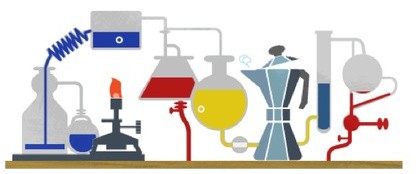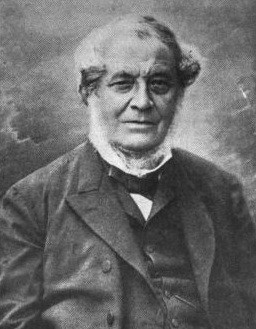 The Google Doodle for the day celebrates scientist Robert Bunsen on his 200th birthday. And a lovely Google Doodle it is! (Although technically, shouldn’t the Bunsen Burner flame be colorless?)
The Google Doodle for the day celebrates scientist Robert Bunsen on his 200th birthday. And a lovely Google Doodle it is! (Although technically, shouldn’t the Bunsen Burner flame be colorless?)
The second ‘G’ in the Doodle is a moka pot for brewing coffee. Which got us wondering: Just a random touch, or did Robert Bunsen actually do something famous with coffee? Was he a wonderful roaster, or a Voltaire-style coffee devotee, drinking 50 cups a day?
The answer: apparently not. We don’t find a connection. The thing we do find (repeatedly) is this inside joke for chemists:
Bunsen Burner: A device invented by Robert Bunsen (1811-1899) for brewing coffee
in the laboratory, thereby enabling the chemist to be poisoned without having to go all the way to the company cafeteria.
Honestly, those scientists! (Though you can in fact get a Bunsen burner stand for your in-lab espresso fix.)
 Coffee was for sure available in Bunsen’s time. The first coffee house in Berlin opened in 1722, 90 years before Bunsen was born. The paper coffee filter was invented in Germany 100 years after Bunsen’s birth, so you know they were thinking about it. But historically, there is no special Bunsen love for coffee.
Coffee was for sure available in Bunsen’s time. The first coffee house in Berlin opened in 1722, 90 years before Bunsen was born. The paper coffee filter was invented in Germany 100 years after Bunsen’s birth, so you know they were thinking about it. But historically, there is no special Bunsen love for coffee.
There IS one minor connection, however: rubidium. Bunsen and Gustav Kirchhoff discovered the element in 1861; it’s right next to strontium on the Periodic Table. And rubidium, as we all know,
“…is found in small quantities in tea, coffee, tobacco, and other plants, and trace quantities of the element may be required by living organisms.”
So as you drink your morning coffee (maybe from a moka pot) and get that tasty trace of rubidium, thank Robert Bunsen.
See our full Robert Bunsen biography »
